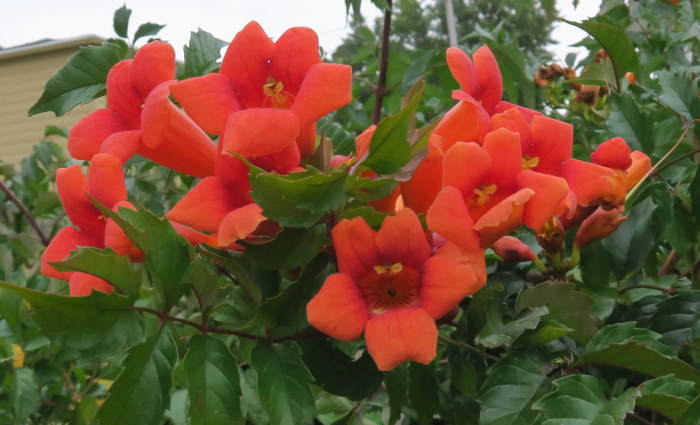While some summer wildflowers are easy to overlook, you can’t miss Trumpet vine (Campsis radicans) when it’s in bloom. Also known as Trumpet creeper, this woody vine is native to most of the U.S. but “can be weedy or invasive.” I haven’t seen it displacing native plants in Iowa, though.
A “favorite of hummingbirds” thanks to its large orange or reddish flowers, trumpet vine easily attaches itself to other plants, fences, or buildings.
I took most of the pictures enclosed below this week in Windsor Heights or Des Moines.
Illinois Wildflowers describes the leaves and shoots, which are initially “greenish brown, but become brown and woody as they mature.” Here’s a closer view of older vines wrapped around a telephone pole near Ingersoll and 57th Street in Des Moines.
I photographed the same plant in 2018.
The conspicuous flowers appear in clusters around midsummer. We’re approaching the end of the blooming period now; I took this picture a few years ago.
However, a large trumpet vine in Windsor Heights still had some unopened flowers this week.
U.S. Wildflowers observes, “Not only is the blossom reddish-orange, the calyx usually matches the blossom.”
According to Illinois Wildflowers, the reddish lines “Along the inner surface of the corolla […] function as nectar guides” for pollinators that include sphinx moths and some kinds of bees as well as hummingbirds. You can see the faint lines in the next two photographs.
As flowers age, the corolla turns brown.
The seed pods of trumpet vine are large, like the flowers. You can see them forming in this shot.
The transformation continues.
The U.S. Wildflowers site notes that trumpet vine “can climb high in forest canopies, with old plants reaching heights of 60 or 70 feet.” I’ve never seen one that large in the wild, but on a lunch stop in Dallas Center several years ago I spotted the largest trumpet vine I’ve ever seen.














